The AMD Trinity Review (A10-4600M): A New Hope
by Jarred Walton on May 15, 2012 12:00 AM ESTAMD Trinity General Performance
Starting as usual with our general performance assessment, we’ve got several Futuremark benchmarks along with Cinebench and x264 HD encoding. The latter two focus specifically on stressing the CPU while PCMarks will cover most areas of system performance (including a large emphasis on storage) and 3DMarks will give us a hint at graphics performance. First up, PCMark 7 and Vantage:
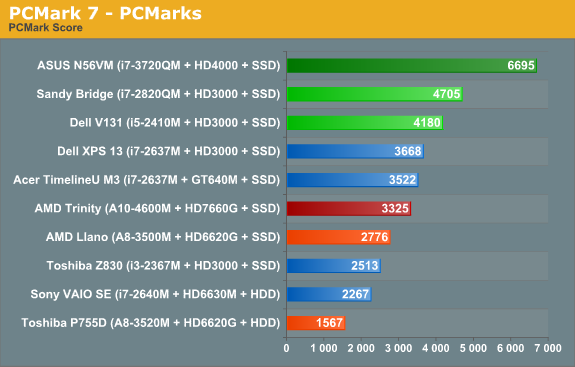
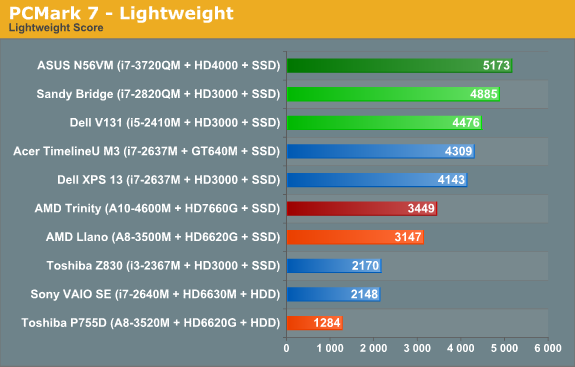
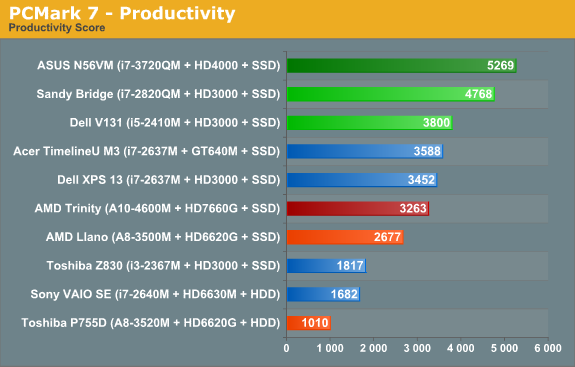

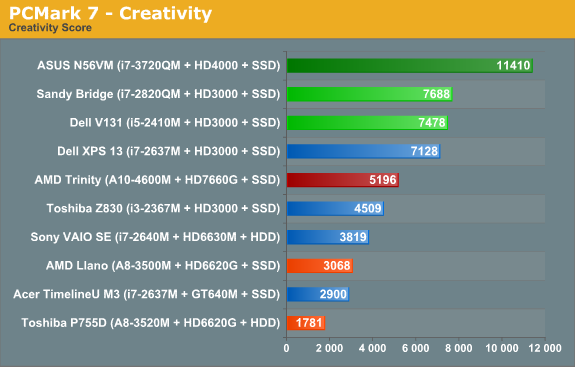
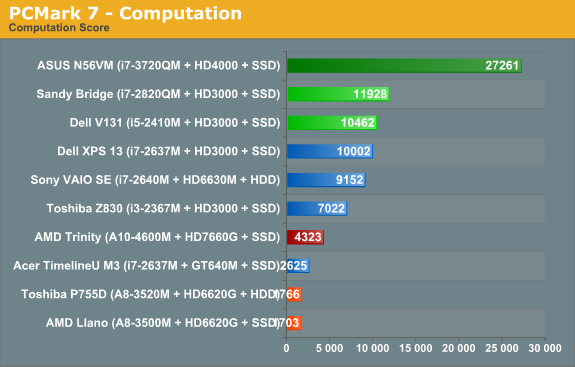
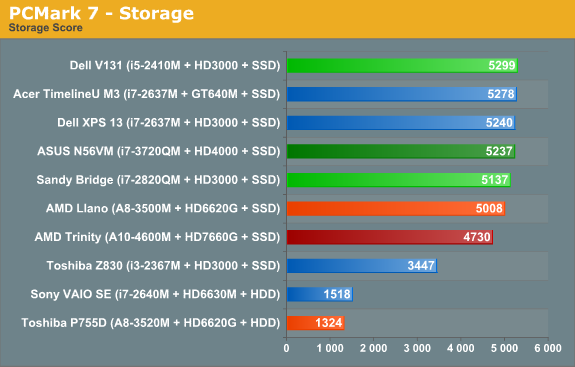
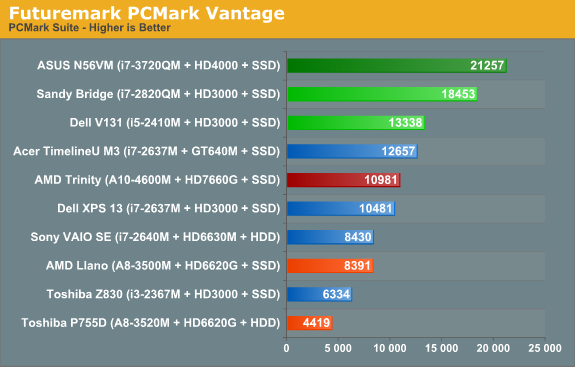
As noted earlier, we ran several other laptops through PCMark 7 and PCMark Vantage testing using the same Intel 520 240GB SSD, plus all the ultrabooks come with SSDs. That removes the SSD as a factor from most of the PCMark comparisons, leaving the rest of the platform to sink or swim on its own. And just how does AMD Trinity do here? Honestly, it’s not too bad, despite positioning within the charts.
Obviously, Intel’s quad-core Ivy Bridge is a beast when it comes to performance, but it’s a 45W beast that costs over $300 just for the CPU. We’ll have to wait for dual-core Ivy Bridge to see exactly how Intel’s latest stacks up against AMD, but if you remember the Llano vs. Sandy Bridge comparisons it looks like we’re in for more of the same. Intel continues to offer superior CPU performance, and even their Sandy Bridge ULV processors can often surpass Llano and Trinity. In the overall PCMark 7 metric, Trinity ends up being 20% faster than a Llano A8-3500M laptop, while Intel’s midrange i5-2410M posts a similar 25% lead on Trinity. Outside of the SSD, we’d expect Trinity and the Vostro V131 to both sell for around $600 as equipped.
A 25% lead for Intel is pretty big, but what you don’t necessarily get from the charts is that for many users, it just doesn’t matter. I know plenty of people using older Core 2 Duo (and even a few Core Duo!) laptops, and for general office tasks and Internet surfing they’re fine. Llano was already faster in general use than Core 2 Duo and Athlon X2 class hardware, and it delivered great battery life. Trinity boosts performance and [spoiler alert!] battery life, so it’s a net win. If you’re looking for a mobile workstation or something to do some hardcore gaming, Trinity won’t cut it—you’d want a quad-core Intel CPU for the former, and something with a discrete GPU for the latter—but for everything else, we’re in the very broad category known as “good enough”.


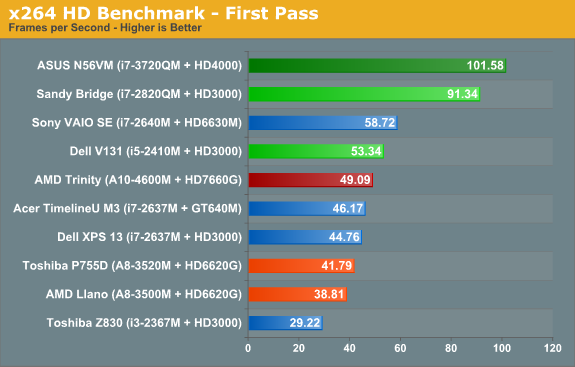
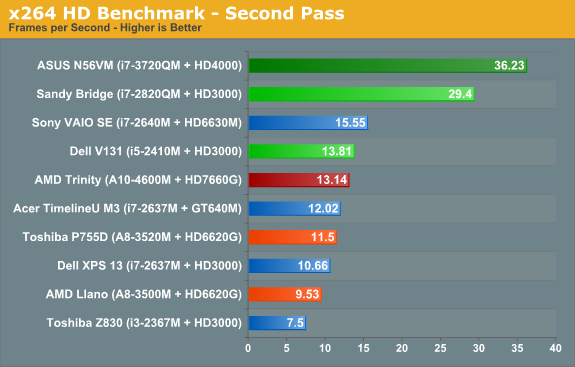
When we start drilling down into other performance metrics, AMD’s CPU performance deficiency becomes pretty obvious. The Cinebench single-threaded score is up 15% from 35W Llano, but in a bit of a surprise the multi-threaded score is basically a wash. Turn to the x264 HD encoding test however and Trinity once again shows a decent 15% improvement over Llano. Against Sandy Bridge and Ivy Bridge, though? AMD’s Trinity doesn’t stand a chance: i5-2410M is 50% faster in single-threaded Cinebench, 27% faster in multi-threaded, and 5-10% faster in x264. It’s a good thing 99.99% of laptop users never actually run applications like Cinebench for “real work”, but if you want to do video encoding a 10% increase can be very noticeable.

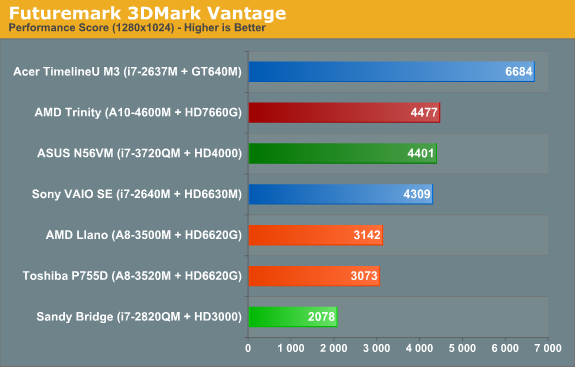
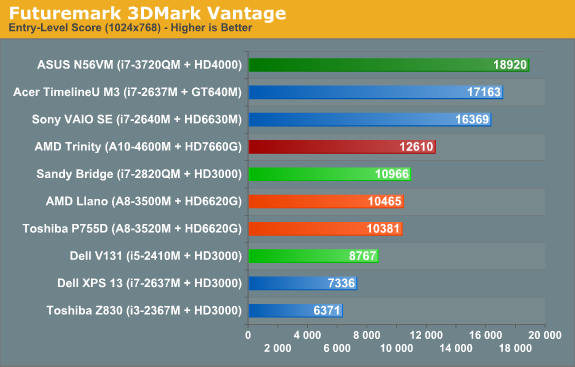
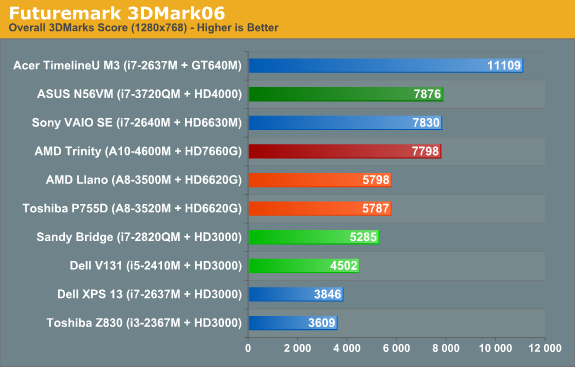
Shift over to graphics oriented benchmarks and the tables turn once again...sort of. Sandy Bridge can’t run 3DMark11, since it only has a DX10 class GPU, but in Vantage Performance and 3DMark06 Trinity is more than twice as fast as HD 3000. Of course, Ivy Bridge’s HD 4000 is the new Intel IGP Sheriff around these parts, and interestingly we see Trinity and i7-3720QM basically tied in these two synthetics. (We’ll just ignore 3DMark Vantage’s Entry benchmark, as it’s so light on graphics quality that we’ve found it doesn’t really stress most GPUs much—even low-end GPUs like HD 3000 score quite well.) We’ll dig into graphics performance more with our gaming benchmarks next.










271 Comments
View All Comments
Spunjji - Wednesday, May 16, 2012 - link
Go away, please.silverblue - Thursday, May 17, 2012 - link
Can you and sans2212 go into a room and fight it out, please? One of you hates AMD, the other wants its babies, and I've a sneaky suspicion that, like matter and antimatter, you might actually cancel each other out.(they also both cease to exist, but I thought that'd be a bit cruel)
e36Jeff - Tuesday, May 15, 2012 - link
oh well, thanks for checking, and thanks for the reply. I guess I'll just have to wait for you guys to get your hands on an actual LV/ULV trinity chip.plonk420 - Tuesday, May 15, 2012 - link
is the Dell V131 tested 2, 4, or 6gb? (i.e. single or dual channel) and how about the other laptops?JarredWalton - Tuesday, May 15, 2012 - link
I actually stuck in 2x4GB DDR3-1600 from the IVY system to make things "equal". Sorry for not noting that. I did the same for Llano, Trinity, and QC SNB. Same SSD, same RAM -- though Llano and SNB ran the RAM at DDR3-1333.Iketh - Tuesday, May 15, 2012 - link
Awesome article Jarred!I caught only one mistake...
"Power consumption is also improved over Llano, making Trinity is a win across the board for AMD compared to its predecessor."
SuperVeloce - Tuesday, May 15, 2012 - link
"Llano was already faster in general use than Core 2 Duo and Athlon X2 class hardware."This is so wrong, it's beggar belief. Just for comparison, my old C2D T8300 (2,4ghz, 3mb L2) is actually faster than A4-3300 overclocked to 2,8ghz in every task and benchmark i throw at them. Even at 2,6ghz it's only on par with T7500 (2,2ghz, 4mb L2, year 2006 my friends).
Well yes, I guess A4 (not overclocked) is less power-hungry and can do quite a bit of undervolting but you see my point... liano is slower than equivalent mobile c2d, if Open-CL from gpu is not in use.
JarredWalton - Tuesday, May 15, 2012 - link
Care to provide some specific benchmarks that prove this out? Because by my numbers, it doesn't look that way:http://www.anandtech.com/show/2585/6
I didn't post Cinebench 10 in the article, but Trinity scores 2834 single-threaded and 8222 multi-threaded. That makes the single-threaded score basically tied with the Core 2 Duo X7900 (2.8GHz) and the multi-threaded score is 50% faster. Llano on the other hand scores 2037 and 6824 in the same tests -- slightly slower than P8400 on single threads but faster on multi-threaded.
PCMark 05 I can provide results for as well, though the SSD certainly skews things on Trinity. Trinity = 10824, Llano (HDD) = 6236, P8400 = 6561 (close enough to Llano), and X7900 = 7544. But I'm not talking specific tasks; I simply said "faster in general use" -- depending on which version of Llano you're talking about. The fastest Core 2 vs. the slowest A8 would probably be a tossup on the CPU side.
eanazag - Tuesday, May 15, 2012 - link
I am disappointed that the desktop versions are not available till Q3. I was thinking this would replace my Core i3 540 at home soon.PolarisOrbit - Tuesday, May 15, 2012 - link
I am wondering if there is a better way to communicate value other than pricing because throughout the article the reviewer estimates Trinity at $600, while in the comments to readers the same reviewer's estimates vary from $700-$800.What is to be made of this discrepency? I am wondering if it wouldn't be better to just avoid price predictions altogether. Surely there is some other way of describing relative value. Maybe estimates of what other setups would have similar performance is enough by itself.